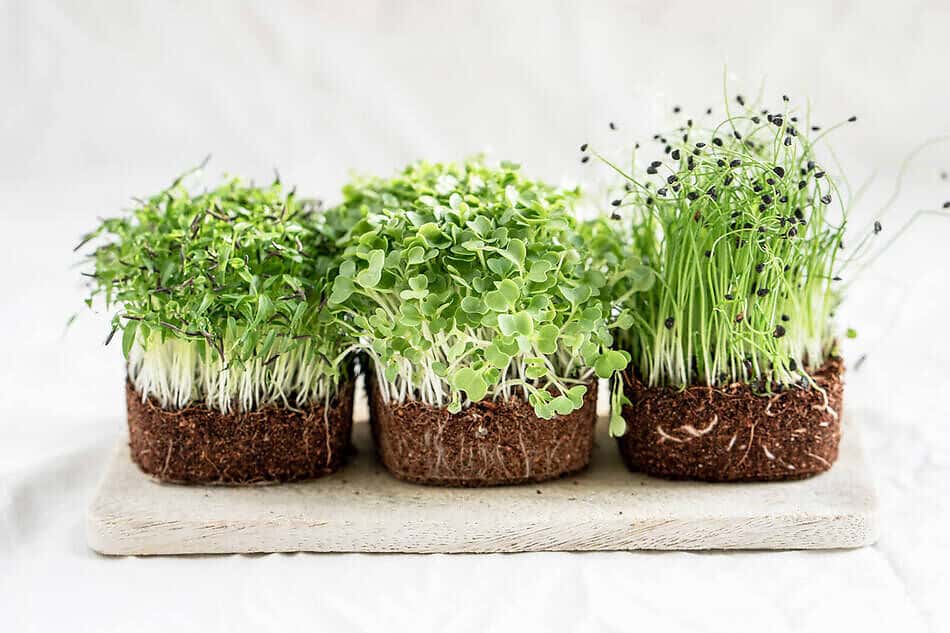Microgreens can do wonders for your body, they’re rich in a wide range of micronutrients, which we mostly tend to ignore in our diets, but are extremely important for the nourishment of our eyes, skin, and internal organs, and overall mental and physical health. Bearing in mind these advantages, in this article, I shall tell you about what are the healthiest microgreens and why are they healthy and why should you eat microgreens, so let’s enhance our knowledge about what are the healthiest microgreens, shall we?
What Are The Healthiest Microgreens?
Microgreens are nutrient-dense greens that are typically grown from the seeds of vegetables and herbs. They are usually harvested when they are about two inches tall and can be used as a garnish or added to salads, sandwiches, and stir-fries. While all microgreens are packed with nutrients, some varieties are especially healthy.
One of the most nutrient-rich microgreens is red cabbage. This variety is an excellent source of vitamins A, C, and K, as well as fiber and magnesium. Red cabbage microgreens also contain compounds that have been shown to reduce inflammation and protect against cancer. Another healthy option is arugula, which is a good source of vitamins A, C, and E. Arugula microgreens also contain chlorophyll, which has been shown to detoxify the body and improve digestion.
Other nutrient-rich microgreens include beet greens, chard, cilantro, kale, and parsley. All of these varieties are low in calories but high in vitamins, minerals, antioxidants, and other health-promoting compounds. In addition to being healthy, microgreens are also incredibly versatile. They can be used in a variety of dishes or simply enjoyed on their own as a healthy snack.
So next time do add a portion of nutrient-rich microgreens into your diet and enjoy the taste of freshness!
What Are Microgreens?
Microgreens are tiny greens that pack a big flavor punch. They are usually grown from the seeds of vegetables and herbs, and they can be harvested just a few weeks after planting.
Microgreens are often used as a garnish or added to salads, but they can also be enjoyed on their own as a healthy snack. In addition to their bold flavor, microgreens are also a good source of vitamins and minerals. So next time you’re looking for a little something extra to add to your meal, reach for some microgreens and enjoy the taste of freshness.
What Are Some Of The Most Popular Microgreens?
Microgreens are a type of vegetable that is harvested when the plant is still young. These greens can be used to add flavor and visual appeal to salads, sandwiches, and other dishes.
Some of the most popular microgreens include peas, beans, radishes, and mustards. Microgreens are relatively easy to grow, and they can be grown indoors or outdoors. To get started, simply soak some seeds in water for a few hours, then plant them in a pot or tray of moist soil. Once the seedlings have emerged, thin them out so that each plant has enough room to grow.
When the plants are about four weeks old, they will be ready to harvest. Simply snip the greens off at the stem, using sharp scissors or a knife. Remember to wash the greens thoroughly before eating them. With a little care and patience, you can enjoy fresh microgreens all year long!

What Are The Health Benefits Of Microgreens?
Microgreens are nutrient-dense greens that are typically grown from the seeds of vegetables and herbs. They are usually harvested when they are about two inches tall and can be used as a garnish or added to salads, sandwiches, and stir-fries. While all microgreens are packed with nutrients, some varieties are especially healthy.

One of the most nutrient-rich microgreens is red cabbage. This variety is an excellent source of vitamins A, C, and K, as well as fiber and magnesium. Red cabbage microgreens also contain compounds that have been shown to reduce inflammation and protect against cancer. Another healthy option is arugula, which is a good source of vitamins A, C, and E. Arugula microgreens also contain chlorophyll, which has been shown to detoxify the body and improve digestion.
Other nutrient-rich microgreens include beet greens, chard, cilantro, kale, and parsley. All of these varieties are low in calories but high in vitamins, minerals, antioxidants, and other health-promoting compounds. In addition to being healthy, microgreens are also incredibly versatile. They can be used in a variety of dishes or simply enjoyed on their own as a healthy snack. So next time you’re looking for nutrient-rich food to add to your diet, reach for some microgreens and enjoy the taste of freshness!
What Are The Different Types Of Microgreens?
There are many different types of microgreens, and they come in a wide variety of colors, flavors, and textures. Some of the most popular varieties include arugula, beet greens, chard, cilantro, kale, and parsley. Each type of microgreen has its own unique flavor and nutritional profile.
Arugula is a good source of vitamins A, C, and E. Arugula microgreens also contain chlorophyll, which has been shown to detoxify the body and improve digestion.
Beet greens are a good source of vitamins A, C, and K, as well as fiber and magnesium. Beet greens microgreens also contain compounds that have been shown to reduce inflammation and protect against cancer.
Chard is a good source of vitamins A, C, and E. Chard microgreens also contain chlorophyll, which has been shown to detoxify the body and improve digestion.
Cilantro is a good source of vitamins A, C, and K, as well as fiber and magnesium. Cilantro microgreens also contain compounds that have been shown to reduce inflammation and protect against cancer.
Kale is a good source of vitamins A, C, and K, as well as fiber and magnesium. Kale microgreens also contain compounds that have been shown to reduce inflammation and protect against cancer.
Parsley is a good source of vitamins A, C, and E. Parsley microgreens also contain chlorophyll, which has been shown to detoxify the body and improve digestion.
Conclusion
So, to answer what are the healthiest microgreens, the healthiest microgreens are those that are high in vitamins, minerals, antioxidants, and other health-promoting compounds. Some of the most nutrient-rich microgreens include red cabbage, arugula, beet greens, chard, cilantro, kale, and parsley. All of these varieties are low in calories but high in nutrients, making them an excellent addition to any healthy diet.
Thanks for reading!

